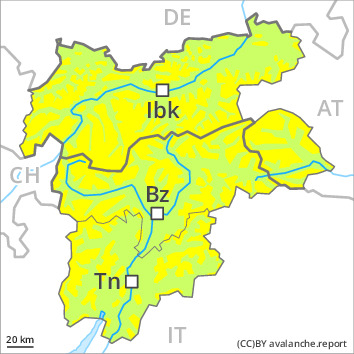
Danger level
 | treeline |
|  |
|  |

Wind slabs represent the main danger.
As a consequence of new snow and a sometimes strong northerly wind, sometimes avalanche prone wind slabs formed in the last few days above the tree line. Avalanches can in some places be released, even by a single winter sport participant and reach medium size. Avalanche prone locations for dry avalanches are to be found on steep west, north and east facing slopes. At elevated altitudes the avalanche prone locations are present in all aspects. In the regions exposed to heavier precipitation the avalanche prone locations are larger. Such avalanche prone locations are to be found in particular at the base of rock walls and behind abrupt changes in the terrain, and in gullies and bowls. Wind slabs are clearly recognisable to the trained eye. They are to be bypassed in steep terrain.
Dry avalanches can additionally in very isolated cases be released in deep layers by large loads. This applies in particular on extremely steep shady slopes above approximately 2400 m in areas where the snow cover is rather shallow.
Snowpack
dp.6: cold, loose snow and wind
dp.7: snow-poor zones in snow-rich surrounding
In some places various wind slab layers are lying on soft layers. As a consequence of low temperatures the snowpack can settle hardly at all. Wind slabs remain in some cases prone to triggering, especially on steep shady slopes.
The old snowpack will be subject to considerable local variations. In very isolated cases weak layers exist in the centre of the old snowpack in particular on shady slopes. This applies in particular above approximately 2400 m.
Tendency
The avalanche danger will persist. Fresh wind slabs require caution.
